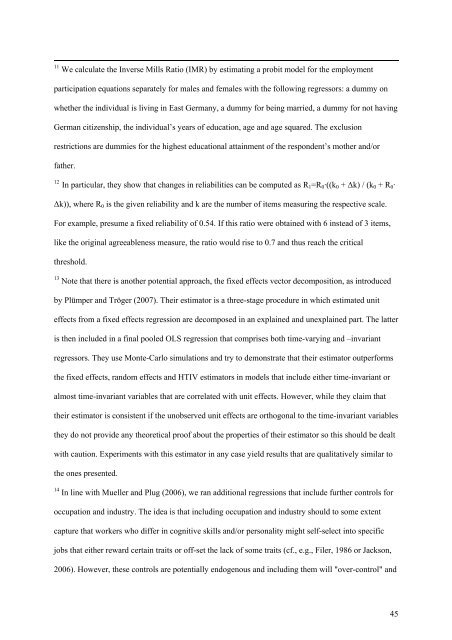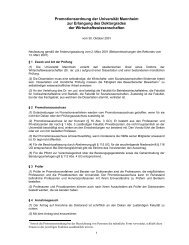The returns to cognitive and non-cognitive abilities in Germany
The returns to cognitive and non-cognitive abilities in Germany
The returns to cognitive and non-cognitive abilities in Germany
You also want an ePaper? Increase the reach of your titles
YUMPU automatically turns print PDFs into web optimized ePapers that Google loves.
11 We calculate the Inverse Mills Ratio (IMR) by estimat<strong>in</strong>g a probit model for the employment<br />
participation equations separately for males <strong>and</strong> females with the follow<strong>in</strong>g regressors: a dummy on<br />
whether the <strong>in</strong>dividual is liv<strong>in</strong>g <strong>in</strong> East <strong>Germany</strong>, a dummy for be<strong>in</strong>g married, a dummy for not hav<strong>in</strong>g<br />
German citizenship, the <strong>in</strong>dividual’s years of education, age <strong>and</strong> age squared. <strong>The</strong> exclusion<br />
restrictions are dummies for the highest educational atta<strong>in</strong>ment of the respondent’s mother <strong>and</strong>/or<br />
father.<br />
12<br />
In particular, they show that changes <strong>in</strong> reli<strong>abilities</strong> can be computed as R 1 =R 0·((k 0 + Δk) / (k 0 + R 0·<br />
Δk)), where R 0 is the given reliability <strong>and</strong> k are the number of items measur<strong>in</strong>g the respective scale.<br />
For example, presume a fixed reliability of 0.54. If this ratio were obta<strong>in</strong>ed with 6 <strong>in</strong>stead of 3 items,<br />
like the orig<strong>in</strong>al agreeableness measure, the ratio would rise <strong>to</strong> 0.7 <strong>and</strong> thus reach the critical<br />
threshold.<br />
13 Note that there is another potential approach, the fixed effects vec<strong>to</strong>r decomposition, as <strong>in</strong>troduced<br />
by Plümper <strong>and</strong> Tröger (2007). <strong>The</strong>ir estima<strong>to</strong>r is a three-stage procedure <strong>in</strong> which estimated unit<br />
effects from a fixed effects regression are decomposed <strong>in</strong> an expla<strong>in</strong>ed <strong>and</strong> unexpla<strong>in</strong>ed part. <strong>The</strong> latter<br />
is then <strong>in</strong>cluded <strong>in</strong> a f<strong>in</strong>al pooled OLS regression that comprises both time-vary<strong>in</strong>g <strong>and</strong> –<strong>in</strong>variant<br />
regressors. <strong>The</strong>y use Monte-Carlo simulations <strong>and</strong> try <strong>to</strong> demonstrate that their estima<strong>to</strong>r outperforms<br />
the fixed effects, r<strong>and</strong>om effects <strong>and</strong> HTIV estima<strong>to</strong>rs <strong>in</strong> models that <strong>in</strong>clude either time-<strong>in</strong>variant or<br />
almost time-<strong>in</strong>variant variables that are correlated with unit effects. However, while they claim that<br />
their estima<strong>to</strong>r is consistent if the unobserved unit effects are orthogonal <strong>to</strong> the time-<strong>in</strong>variant variables<br />
they do not provide any theoretical proof about the properties of their estima<strong>to</strong>r so this should be dealt<br />
with caution. Experiments with this estima<strong>to</strong>r <strong>in</strong> any case yield results that are qualitatively similar <strong>to</strong><br />
the ones presented.<br />
14 In l<strong>in</strong>e with Mueller <strong>and</strong> Plug (2006), we ran additional regressions that <strong>in</strong>clude further controls for<br />
occupation <strong>and</strong> <strong>in</strong>dustry. <strong>The</strong> idea is that <strong>in</strong>clud<strong>in</strong>g occupation <strong>and</strong> <strong>in</strong>dustry should <strong>to</strong> some extent<br />
capture that workers who differ <strong>in</strong> <strong>cognitive</strong> skills <strong>and</strong>/or personality might self-select <strong>in</strong><strong>to</strong> specific<br />
jobs that either reward certa<strong>in</strong> traits or off-set the lack of some traits (cf., e.g., Filer, 1986 or Jackson,<br />
2006). However, these controls are potentially endogenous <strong>and</strong> <strong>in</strong>clud<strong>in</strong>g them will "over-control" <strong>and</strong><br />
45















